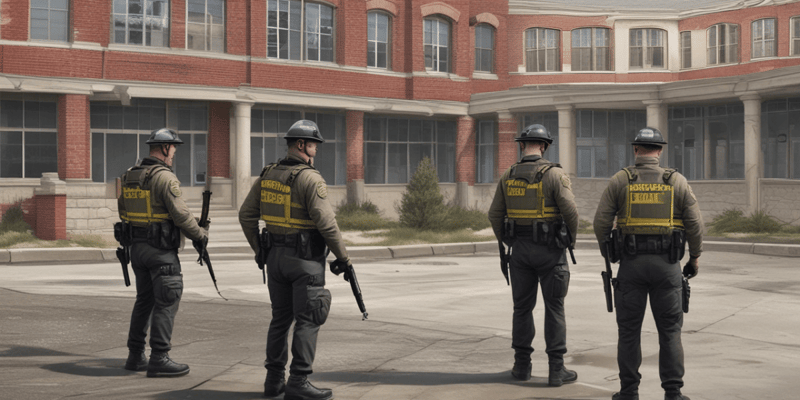Questions and Answers
What is the primary focus of the fire department's efforts after Life Safety and Incident Stabilization benchmarks are achieved?
Which action should be taken first during the demobilization and wrap-up phase?
What is essential to do when conducting a secondary search?
During the wrap-up phase, how should the scene be formally released?
Signup and view all the answers
What should be done to ensure the safety of the public after a fire incident?
Signup and view all the answers
What is a key consideration during the size-up process?
Signup and view all the answers
Which of the following actions should be taken en-route?
Signup and view all the answers
When taking command at an incident scene, what information must be transmitted?
Signup and view all the answers
What should be included in the ongoing size-up process?
Signup and view all the answers
What is the priority when ordering resources for incident control?
Signup and view all the answers
What is the primary goal of the initial incident action plan?
Signup and view all the answers
Which of the following is NOT a benchmark for incident priorities?
Signup and view all the answers
What should be the first assignment in response to incidents focusing on life safety?
Signup and view all the answers
Which strategic mode should be identified to support the incident action plan?
Signup and view all the answers
In the process of adjusting operations, who is responsible for monitoring feedback and progress?
Signup and view all the answers
Study Notes
Response Model
- Companies should switch to a pre-designated tactical subfleet upon en-route.
- Use preplan information related to water supply, special hazards, and access for informed decision-making.
Conduct Size-up
- Conduct a thorough assessment of the incident; dispatch a person for reconnaissance if needed.
- Key considerations include:
- Current fire and scene conditions.
- Ongoing operations that may need adjustment.
- Anticipated construction and its impact.
- Location, extent of the incident, and specific hazards.
- Access and egress points.
- Potential exposures and hazardous materials management (upwind/uphill approach).
- Engage with a property representative for additional insights.
- Maintain an ongoing size-up to adapt and enhance the Incident Action Plan (IAP).
Take Command
- Assume command and communicate key details:
- Name of the commanding officer.
- Correct and clarified incident address.
- Status report, outlining the strategic mode of operation.
Order Resources
- Evaluate and determine resources needed for incident control.
- Request additional alarms and resources as necessary.
Develop Incident Action Plan
- Prioritize life safety in the initial action plan, followed by incident stabilization, then property conservation.
- Utilize a tactical worksheet (TUL 4625/4626) for documentation and effective command transfer.
- Identify the primary and backup strategic modes.
Assignments Based on Strategic Goals
- Make assignments reflecting strategic goals and tactical objectives:
- First priority: Life safety assignments (e.g., Search and Rescue, Rapid Intervention Crew, Evacuation).
- Second priority: Incident stabilization tasks (e.g., Fire Attack, Dam-dike operations).
- Third priority: Property conservation efforts.
Continued Size-up and Monitoring
- Companies must provide feedback and status reports to facilitate adjustments to operations.
- The Incident Commander (IC) uses this information to recalibrate strategies.
Obtain Benchmarks
- Companies are responsible for delivering completion benchmarks for incident priorities:
- Life Safety: "Primary Search All Clear."
- Incident Stabilization: "Fire is Under Control."
- Property Conservation: "Loss Stopped" (not announced publicly).
Shift Priorities
- As benchmarks for Life Safety and Incident Stabilization are met, focus shifts to Property Conservation and Loss Control.
- Communicate anticipated resource requirements and timelines to the assistant chief for effective management of resources.
- Conduct a secondary search with a different crew than that used for the primary search.
Demobilization and Wrap-up
- Engage with property owners or occupants, assigning appropriate officers to aid in the process.
- Distribute "After the Fire" brochures and start making necessary arrangements.
- Perform salvage operations and collaborate on fire overhaul with investigators.
- Ensure premises are restored to a safe condition while investigating cause and origin.
- Account for personnel, check for injuries, and report findings.
- Document the incident details and complete necessary reports.
- Formally release the scene to owners and conduct a safe walk-through.
- Secure the building to ensure public safety.
- Demobilize and return companies to regular service.
- Implement personnel rehabilitation and consider debriefing sessions.
Studying That Suits You
Use AI to generate personalized quizzes and flashcards to suit your learning preferences.
Description
This quiz covers the strategic and tactical considerations outlined in the Emergency Operating Guidelines, specifically Section 300. Participants will learn about the actions taken en-route, conducting a size-up, and critical considerations for effective incident management.




